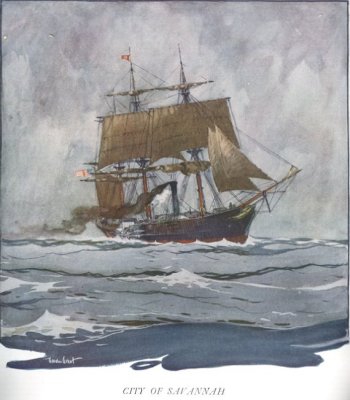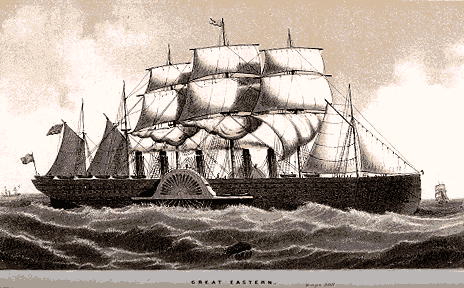Steam Across the Atlantic
Today, drama on the high seas opens the Atlantic to steamships. The University of Houston's College of Engineering presents this series about the machines that make our civilization run, and the people whose ingenuity created them.
Steamboats fairly sprouted in America after Fulton's success in 1807. By 1816 Pittsburgh was turning out steamboats. That year, in the Pittsburgh Gazette, we find,
Those who first cross the Atlantic in a steam boat will [earn great] applause. In a few years we expect such trips will be common ... Bold will they be who first make a passage to Europe in a steam boat.
 Three years later owners mounted engines on the packet City of Savannah. They loaded it with coal -- no cargo or passengers. But they used steam only when they were still in sight of land. After that, they raised sail and rode the Westerlies to England.
Three years later owners mounted engines on the packet City of Savannah. They loaded it with coal -- no cargo or passengers. But they used steam only when they were still in sight of land. After that, they raised sail and rode the Westerlies to England.
Savannah was clearly no real test of steam. And so began a long argument. Enter a self-proclaimed English expert on almost everything. He was the Reverend Dionysius Lardner. In 1835 Lardner set a theoretical upper limit on steamboat range. No ship could carry enough coal to sail more than 2500 miles, he proclaimed.
An American lawyer named Junius Smith had been there when Savannah steamed into Liverpool. By now he was sure Lardner was wrong. The coal capacity of a ship rises as the cube of its length. Coal burning rises only as the square. All you had to do was make your steamboat bigger than ordinary sailing ships.
The great engineer Isambard Kingdom Brunel also thought it could be done. In 1837 he began building the Great Western.
By now Smith had set up a company, but he hadn't built anything yet. Brunel was going to beat him to the punch. So Smith hastily bought a coastal steam packet, rigged it for the open sea, and renamed it Sirius. It was actually too small, so he dispensed with cargo and passengers. All he carried was coal.
In 1838 Sirius set out for New York. Great Western followed three days later, and game was on. Both carried more efficient engines than Savannah had. Still, if Sirius carried no passengers, Great Western carried only seven.
Sirius was the faster ship. So Great Western stokers worked night and day. Sirius hit bad head winds and ran out of coal. When people on Long Island saw her coming, she was burning her supplies for fuel. By the time she reached New York Harbor, a great crowd was there to cheer her in.
Sirius had crossed in record time. Eight hours later, Great Western steamed in and beat that record by three days. Neither ship drew many passengers for the return trip to England. Both took huge financial losses. But in the wake of the great race everyone began building ocean-going steam packets. Steam had conquered the Atlantic, and ocean travel was now changed forever.
I'm John Lienhard, at the University of Houston, where we're interested in the way inventive minds work.
(Theme music)
Wohleber, C., The Annihilation of Time and Space. American Heritage of Invention and Technology, Vol.7, No.1, Spring/Summer 1991, pp. 20-26.

Image courtesy of Special Collections, UH Library
Isambard Brunel's Great Eastern
from Man on the Ocean, 1874